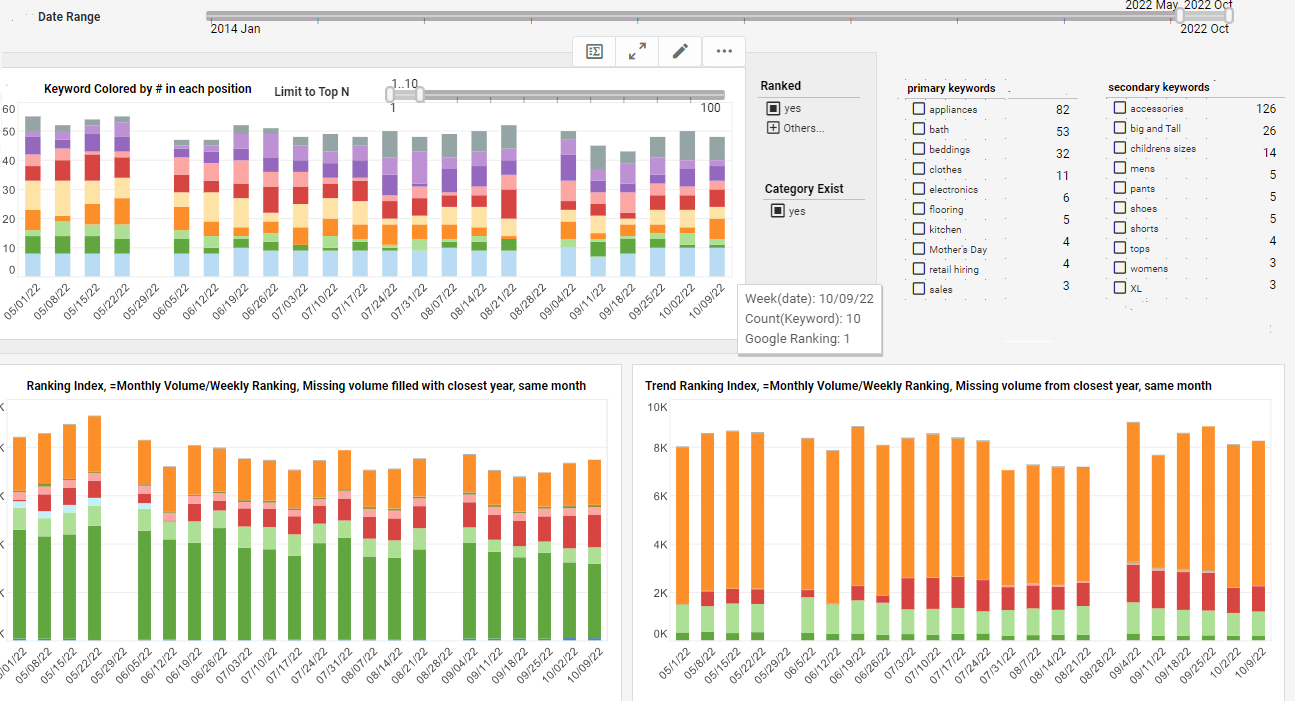Metrics to Monitor on Your SEO Dashboard
There are practically unlimited parameters you may monitor when gauging the effectiveness of your SEO strategy or performing an SEO audit. Here are the top nine SEO metrics and how to track them to assist you in focusing on the proper metrics, regardless of the nature of your organization. Key performance indicators for SEO are essential for a company that expands consistently.
| #1 Ranking: Read how InetSoft was rated #1 for user adoption in G2's user survey-based index | Read More |
Organic Traffic
Let's begin with the most obvious. The traffic you receive from search engine results pages (SERPs) without having to pay for ad placement is known as organic traffic. Narrowing your emphasis to organic traffic demonstrates your website's presence in search for terms related to your business. Your overall traffic may come from a variety of sources (search engines, social networks, direct searches, and other sites). Therefore, if your SEO approach is effective, you should see a consistent increase in the number of visitors coming through search results.
Click-through Rate (CTR)
The percentage of individuals who visit your website after finding it through the SERPs is indicated by your organic click-through rate. Therefore, your page's CTR is 10% if 1,000 users see it listed in the search results and 100 of them click through to visit your website. Organic CTR demonstrates how well your listing (including the title, meta description, and URL) appeals to and engages your audience. If your CTR is poor, your title or meta description may not be compelling, or the content may not be pertinent to the user's search.
Exit Rate
Exit pages are, as the name implies, the last pages that visitors see before leaving your website. The most popular exit pages on your website are the ones that cause visitors to lose interest and leave. It's crucial to monitor your top departure pages because these are the sections of your website where most people leave. Therefore, it may indicate that the page or its content needs improvement if you notice that a significant portion of your traffic drops off after visiting a particular page.
You can do the following to lower your pages' exit rate:
- Make the page design and content organization simple to understand.
- Include calls to action and clear internal links to direct readers to other pages and content that is pertinent to them.
- To better engage visitors, add high-quality information that also includes visuals pictures, and video.
 |
View a 2-minute demonstration of InetSoft's easy, agile, and robust BI software. |
Number of Pages Per Session
Pages per session, a crucial indicator of user engagement on your site, show how many pages on average each user views before leaving. This measure should be as high as possible because it indicates that users are exploring more pages and staying on the site longer. If this score is low, it can be a sign that your material isn't interesting or enough to encourage people to browse further sites. Or it could suggest that the navigation on your website is not user-friendly.
Page Load Time
Your site speed is a crucial SEO ranking criterion that may make or break your rankings (and user experience), both for desktop and mobile. It also checks the load time of the image. If an image is less than 800*600 then the load time of the image will decrease.
Back-links and Domains
One of the most important ranking factors on Google is the number of backlinks. Additionally, a recent analysis of over 11 million Google search results shows that ranks and the quantity of referring domains are strongly correlated. Referring domains are the number of distinct domains from which you have incoming links, whereas back-links are the total number of links pointing from outside sources to your website.
 |
View live interactive examples in InetSoft's dashboard and visualization gallery. |
Keyword Rankings
Monitoring how your rankings for those keywords change is a smart idea as you work on optimizing your website to rank for your target keywords. Knowing the keywords you are now ranking for helps you gauge your current share of organic search visibility, which helps you choose whether to concentrate on further optimizing for those keywords or on other phrases you want to rank for but haven't yet. Tools can be used to monitor the rankings of your keywords. Some other tools can be used to monitor how your keywords are performing. You can track ranking changes over time and observe how your total search visibility is increasing by using the Organic Search Positions report.
Ranking Index
Download your keyword rankings each week and save into a spreadsheet. Find the seach volumes for the keywords. Create a formula dividing the volume by the ranking. Add up the calculations across all the keywords. Watching how this total increases or decreases gives you an overall understanding of the improvements or drops in performance weighted by their importance on your website traffic.
About the Article Contributor: This helpful advice comes from SEO expert, Online Marketing. Consider exploring SEO packages in Dubai to enhance your website's performance and improve your search engine rankings.


